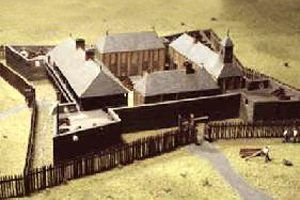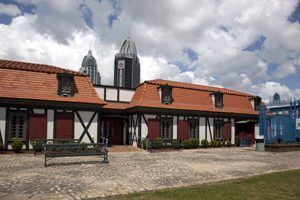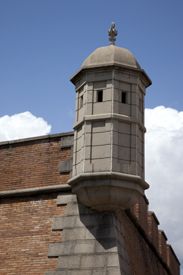
Fort Louis de la Mobile, Alabama.
Located in Mobile, Alabama, Fort Conde was originally founded by Jean-Baptiste Le Moyne de Bienville in 1702 as Fort Louis de la Mobile at 27-Mile Bluff. Originally a part of French Louisiana, the Alabama Gulf Coast was a focal point for colonial exploration and settlement. Mobile was the capital of the French colony when it was founded at its original site up the Mobile River in 1702. Its Roman Catholic parish dates back to 1703.
After the Mobile River flooded and damaged the fort, the post and settlement of Mobile were relocated in 1711 to their current site. There, a temporary wooden stockade fort, also named Fort Louis, was constructed. The capital was moved to Biloxi in 1720, but Mobile remained a vital community for the French.
In 1723, construction of a new brick fort with a stone foundation began, and the fort was renamed Fort Condé in honor of King Louis XIV’s brother, the Prince of Condé. A dry moat and additional earthwork defenses surrounded the large, bastioned structure. Fort Condé and its surrounding buildings covered about 11 acres of land. It was shaped in a seven-pointed star, with guard towers raised at the points with significant surrounding earthworks. In design, it is similar to the Spanish fort Castillo de San Marcos in St. Augustine, Florida. A crew of 20 black slaves and five white workmen performed the original work on the fort.
The fort’s objective was to defend against a British or Spanish attack on the easternmost part of the French Louisiana colony. The strategic importance of Mobile and Fort Condé was significant as the fort protected access into the strategic region between the Mississippi River and the Atlantic colonies along the Alabama and Tombigbee Rivers. It also served as a base for French exploration and expansion into much of the modern state of Alabama. Supplies and troops for upriver forts such as Fort Toulouse (near present-day Montgomery) were dispatched from Fort Conde, and it functioned as the military headquarters for the region. Fort Condé guarded Mobile and its citizens for almost 100 years, from 1723 to 1820.

Fort Conde, Mobile, Alabama.
Fort Conde remained in the hands of its French builders until 1763, when it was turned over to the British and the rest of Alabama as part of the agreement that ended the French and Indian War.
The British renamed the post Fort Charlotte in honor of King George III’s wife and maintained a garrison throughout the American Revolution. An original cannon from the British era can be seen across the walk from the old French gun at the Conde-Charlotte House. During this time, Mobile prospered as a commercial center and became a target of Spain after that country allied itself with the United States during the American Revolution.
On February 10, 1780, General Bernardo de Galvez landed a force of Spanish troops and American volunteers to begin the Battle of Fort Charlotte, one of two significant battles of the American Revolution fought in Alabama. The allied troops laid siege to the fort and, for four weeks, battled Fort Charlotte’s British garrison for control not only of the fortress but all of Mobile Bay. The British surrendered on March 14, 1780, ending England’s claim to present-day Alabama forever.
Under Spanish rule, the fort was renamed Fort Carlota. In addition to placing a garrison in Mobile, Galvez ordered the construction of a new fort on the bluffs across the bay at the site of today’s community of Spanish Fort. This work withstood a last British attack and gave the community the name that it bears today. The Spanish held the fort until 1813, when United States Troops occupied it.
Under U.S. control, the fort was renamed Fort Charlotte. In 1820, the U.S. Congress authorized the sale and removal of the fort because it was no longer needed for defense. Later, city funds paid for the demolition to build new streets eastward towards the river and southward. By late 1823, most of the above-ground traces of Mobile’s fort were gone, leaving only underground structures.
In the 1970s, about 1/3 of the fort was reconstructed at an 80% scale. The new Fort Conde was opened on July 4, 1976, as part of Mobile’s celebration of the United States bicentennial. Today, the reconstructed fort serves as the official Welcome Center for the City of Mobile. It is located at 150 South Royal Street and is free to visit.

Fort Conde, Mobile, Alabama.
Compiled and edited by Kathy Alexander/Legends of America, updated May 2025.
Also See:
Fort Morgan – Stronghold of Mobile Bay
Forts & Presidios Across America
Sources:
